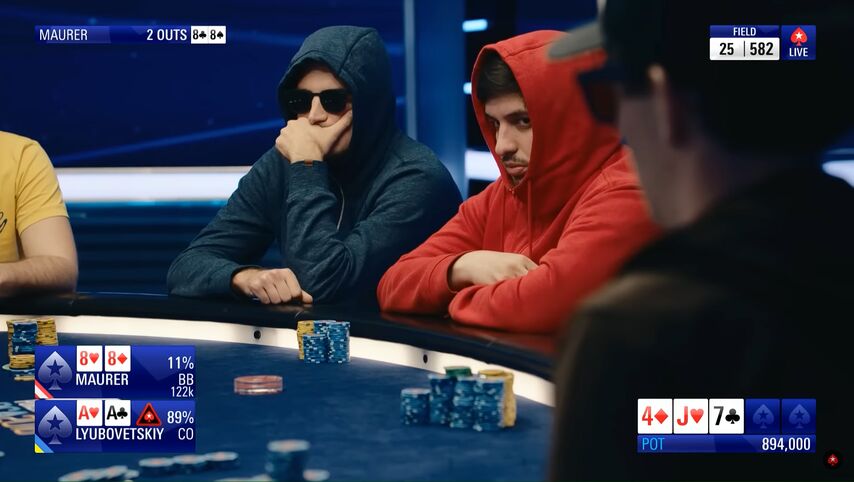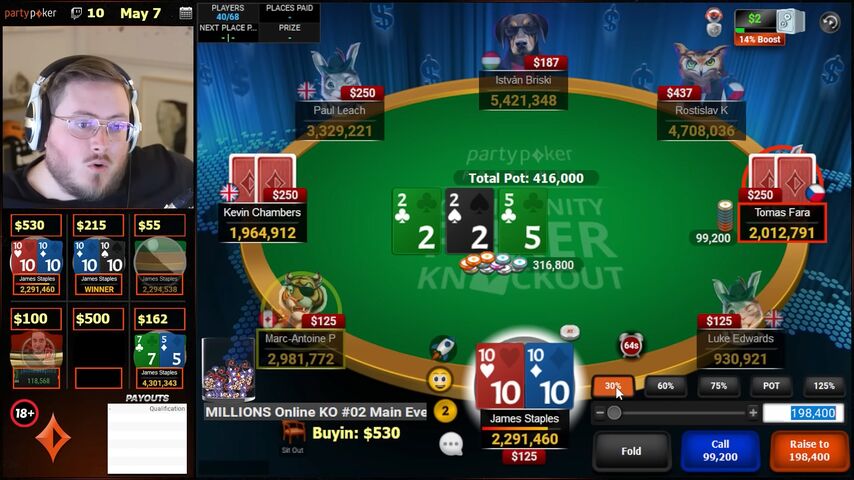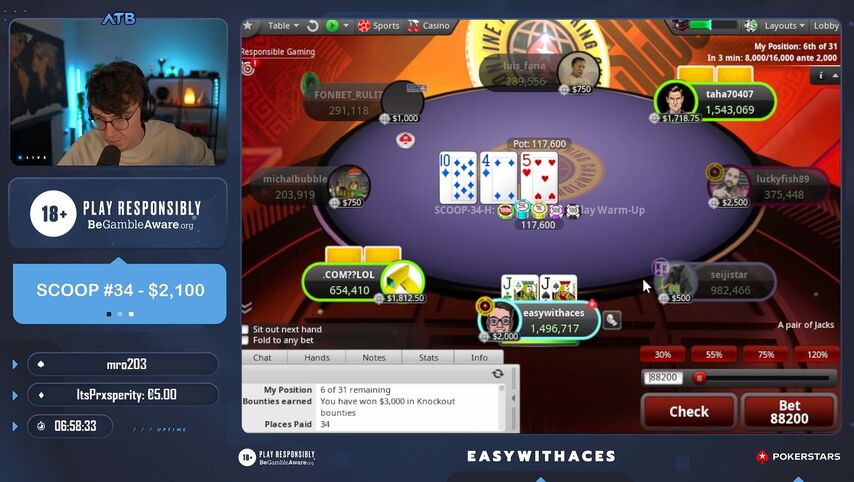What is a overpair in poker and how should you play when you have one?
Overpair is a basic poker term for a pocket pair that is higher than any card on the board (community cards). Overpairs happen postflop and the term is not used for preflop hands.
If a player holds K♥ K♣ on a board of 3♦ 8♣ 10♦ 10♠ J♥, they’ve got an overpair.
The smaller your pocket pair is (like 5-5, 6-6, etc), the more likely it is that you will see overcards on the flop. An overcard is any card that is ranked higher than your paired cards.
Having an overpair is a good spot to be in, but it comes with some dangers. For example, when you have an overpair, you usually don’t have other draws to improve. Your opponents, on the other hand, can have draws, two-pairs, and other hands that beat your overpair.
We’ll start with a few clear examples of overpairs, then talk about strategy.

Example of an Overpair in Poker
Let’s get more familiar with overpairs by looking at a quick example.
Jamie Staples, ambassador for partypoker, has a great situation unfolding in front of him.
Jamie is on the button with an overpair, meaning he’s in an ideal position at the table with a strong hand.

Anytime you have an overpair, you are ahead of lots of hands your opponents could have.
With 10♥ 10♦, Jamie is ahead of hands like 3-3, 4-4, 6-6, 7-7, 8-8, 9-9, plus any pairs of 5s like A-5, 4-5, 5-6, 5-7, and other reasonable hands.
We also have to remember some of the draws that he may be up against. There are two clubs on the board, which means if players continue to the turn, they may be on a flush draw.
Straight draws are less likely, though Jamie may be up against A-3 and A-4 sometimes.
10♥ 10♦ is only behind a few hands, like 5♥-5♦, 5♦-5♠, 5♥-5♠, A-2, J-J, Q-Q, K-K, and A-A.
Hopefully, this example gave you some insight into playing overpairs. Let’s dive a little deeper.
Tips for Playing Overpairs in Poker
1. Play your overpairs quickly and aggressively (most of the time).
Playing aggressively with your overpairs will do two major things for you.
Firstly, your aggression will isolate one or two players, instead of several opponents, meaning that your equity increases.
Secondly, you’ll have a better chance of getting more chips into the pot, while you are ahead of your opponent.
2. Set some traps with your strongest overpairs.
Remember; if you always take the same line in poker, you will be too predictable. You should play with a mixed strategy, occasionally disguising the strength of your hand. By doing this, you can hands like top pair and middle pair to bet into you.
3. Avoid playing multiway pots out of position with overpairs.
If you get dealt a strong pocket pair out of position, you should always avoid playing multiway pots. Your equity is at its lowest, even with premium hands. Try to thin the field and choose a preflop raise size that gets you heads-up with an opponent.

The Problem with Over-Playing Overpairs
Overpairs are strong, but they are never the nuts. An overpair is not even the second, or third-best possible hand on a flop. There’s no question that you will be ahead most of the time, but don’t overplay your overpair.
A lot can change when the flop is dealt and your overpair might not be as strong as it looks. Beginner players sometimes “fall in love” with a big hand like Jacks, Queens, Kings, or Aces. It causes them to commit their chips to the pot, sometimes with very low equity.
Here’s an example hand to illustrate the dangers of overplaying an overpair.
You have Q♥ Q♦ and the flop is showing 6♠ 7♦ 9♠.
You bet about ½ pot and your opponent raises. It’s unlikely they have a straight, so you 3-bet.
Now your opponent moves their large chip stack all in.
This is a disaster for Q♥ Q♦ – and here’s why: Almost any hand that your opponent will choose to go all-in with has a huge amount of equity against your hand.
Most players are going to move all in with hands that are better than one pair.
We can expect hands like:
- Open-ended straight draw (31% – 40% equity against Q♥ Q♦)
- Flush draws (37% – 61% equity against Q♥ Q♦)
- Flush + straight draw (54% – 61% equity against Q♥ Q♦)
- Two pair (about 71% equity against Q♥ Q♦)
- Sets (about 87% equity against Q♥ Q♦)
- Straights (about 96% equity against Q♥ Q♦)
The meaning of all this is, when you get all the money in postflop with an overpair, it’s not great news. At best, you’re doing something called a “coinflip”, where it’s basically 50/50 that you win. At worst, you might be a massive underdog.
Practice your overpair strategy in freerolls. You’ll get to practice for free, but also learn valuable skills, and possibly win cash prizes or tournament tickets.
- Increased first deposit bonus
- Increased rakeback and reloads
- Help with deposits and cashouts
- Access to private freerolls
- Round-the-clock support






















